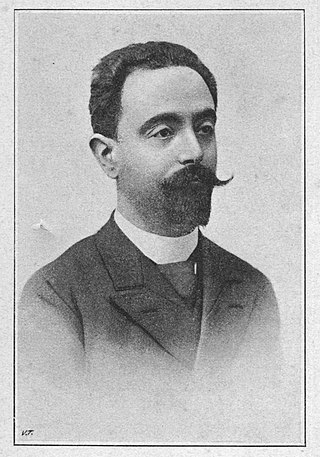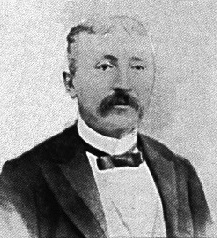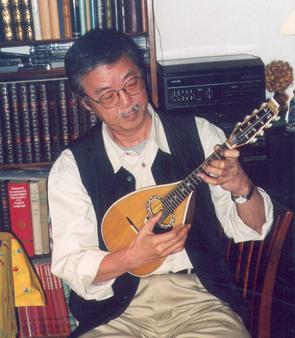Related Research Articles
A mandolin is a stringed musical instrument in the lute family and is generally plucked with a pick. It most commonly has four courses of doubled strings tuned in unison, thus giving a total of eight strings. A variety of string types are used, with steel strings being the most common and usually the least expensive. The courses are typically tuned in an interval of perfect fifths, with the same tuning as a violin. Also, like the violin, it is the soprano member of a family that includes the mandola, octave mandolin, mandocello and mandobass.

Musical composition can refer to an original piece or work of music, either vocal or instrumental, the structure of a musical piece or to the process of creating or writing a new piece of music. People who create new compositions are called composers. Composers of primarily songs are usually called songwriters; with songs, the person who writes lyrics for a song is the lyricist. In many cultures, including Western classical music, the act of composing typically includes the creation of music notation, such as a sheet music "score", which is then performed by the composer or by other musicians. In popular music and traditional music, songwriting may involve the creation of a basic outline of the song, called the lead sheet, which sets out the melody, lyrics and chord progression. In classical music, orchestration is typically done by the composer, but in musical theatre and in pop music, songwriters may hire an arranger to do the orchestration. In some cases, a pop or traditional songwriter may not use written notation at all and instead compose the song in their mind and then play, sing or record it from memory. In jazz and popular music, notable sound recordings by influential performers are given the weight that written or printed scores play in classical music.

Cécile Louise Stéphanie Chaminade was a French composer and pianist. In 1913, she was awarded the Légion d'Honneur, a first for a female composer. Ambroise Thomas said, "This is not a woman who composes, but a composer who is a woman."

Vittorio Monti was an Italian composer, violinist, mandolinist and conductor. His most famous work is his Csárdás, written around 1904.

Katherine Kennicott Davis was an American composer, pianist, arranger, and teacher, whose most well-known composition is the Christmas song "Carol of the Drum," later known as "The Little Drummer Boy".

Bernardo De Pace was an actor, musician and comedic vaudeville entertainer of the 1910s and 1920s, billed as "the Wizard of the Mandolin". He learned to play mandolin in the Italian tradition under Francesco Della Rosa. De Pace's repertoire and technique was described in the Brooklyn Life as involving "the most difficult violin and piano compositions, executed at inconceivably rapid tempi demanding an uncanny technique seldom heard on fretted instruments". In 1927 the Minneapolis Star said that he had been recognized as one of the best mandolinists in the United States. It added that he was more than a mandolinist, that his skill was in playing on human emotions as few musicians were able.

Carlo Munier (1858–1911) was an Italian musician who advocated for the mandolin's acknowledgement among as an instrument of classical music and focused on "raising and ennobling the mandolin and plectrum instruments". He wanted "great masters" to consider the instrument and raise it above the level of "dilettantes and street players" where it had been stuck for centuries. He expected that the mandolin and guitar would be taught in serious orchestral music schools and incorporated into the orchestra. A composer of more than 350 works for the mandolin, he led the mandolin orchestra Reale circolo mandolinisti Regina Margherita named for its patron Margherita of Savoy and gave the queen instruction on the mandolin. As a teacher, he wrote Scuola del mandolino: metodo completo per mandolino, published in 1895.
Angelo Mascheroni was a pianist composer, conductor, and music teacher, brother of the conductor Edoardo Mascheroni. He is most famous for his "Eternamente" for voice and violin, sung by Enrico Caruso; his two-act opera Il mal d'amore, with a libretto by Ferdinando Fontana, was written in 1898. Among his pupils was Spyridon Samaras.

Bluegrass mandolin is a style of mandolin playing most commonly heard in bluegrass bands.

Giuseppe Bellenghi was a virtuoso violoncellist and mandolinist, and composer. He was remembered in 1914 as "a devoted champion of the mandolin."

Ferdinando de Cristofaro was one of the most celebrated mandolin virtuosi of the late 19th Century. He was also a classical pianist, teacher, author and composer, who performed at the chief courts of Europe, and received the royal appointment of mandolinist to the King of Italy.

Herbert J. Ellis was a banjo player, a mandolinist, guitar player and a composer. Music historian Philip J. Bone called him "without question the most fertile English composer and arranger for mandolin and guitar." He was the author of a banjo method, a guitar method, and a Tutor for Mandolin (1892), which he wrote while still in school.

Alexandro Marie Antoin Fridzeri or Frixer was the most renowned of mandolin virtuosi, a clever violinist, organist, and a composer whose works met with popular favor. Among his works were sonatas and chamber music and operas. His life began and ended with tragic notes, losing his eyesight and later his home and possessions. Music historian Philip J. Bone called Fridzeri " an artist of undoubted genius and a man of most remarkable character, which was fully tried under great adversity." The late Giuseppe Bellenghi, mandolinist and composer, dedicated his variations for mandolin and piano on the Carnival of Venice, to the memory of Fridzeri, the blind mandolin player and composer.

Clarence Lockhart Partee was an American composer and arranger and music publisher. He was also founder, editor and publisher of The Cadenza magazine, and devoted his life to teaching and advancing the banjo, mandolin and guitar, arranging more than 150 works for these three instruments. He was a charter member of the American Guild of Banjoists, Mandolinists & Guitarists, now two separate organizations, the American Guild of Music and the Fretted Instrument Guild of America .

Yasuo Kuwahara was a Japanese mandolin player and composer for mandolin orchestra. He was chairman of various musical institutions and organizations, including the Nara National Women's College, the Kuwahara Mandolin Institute and the Japan Association of Music Exchange. In addition, he taught composition and artistic mandolin.

Following its invention and development in Italy the mandolin spread throughout the European continent. The instrument was primarily used in a classical tradition with mandolin orchestras, so called Estudiantinas or in Germany Zupforchestern, appearing in many cities. Following this continental popularity of the mandolin family, local traditions appeared outside Europe in the Americas and in Japan. Travelling mandolin virtuosi like Carlo Curti, Giuseppe Pettine, Raffaele Calace and Silvio Ranieri contributed to the mandolin becoming a "fad" instrument in the early 20th century. This "mandolin craze" was fading by the 1930s, but just as this practice was falling into disuse, the mandolin found a new niche in American country, old-time music, bluegrass and folk music. More recently, the Baroque and Classical mandolin repertory and styles have benefited from the raised awareness of and interest in Early music.
Florence Turner-Maley was an American composer, singer, and teacher.

Agnes Tschetschulin was a Finnish composer and violinist who toured internationally.
Gertrude Jane Martin Rohrer was an American author and composer who wrote many songs, including the state song of Pennsylvania, a book, and at least one operetta. She was active in several music clubs.
References
- 1 2 3 4 Cohen, Aaron I. (1987). International Encyclopedia of Women Composers. Books & Music (USA). p. 601. ISBN 978-0-313-24272-4.
- 1 2 3 4 5 6 7 8 9 10 11 12 13 14 15 16 17 18 19 20 21 22 23 24 25 26 27 28 29 30 31 32 33 34 35 36 Sparks, Paul. "Biography". www.claraross.co.uk. Retrieved 2024-01-23.
- ↑ annepage2013 (2016-01-11). "Clara Ross". The Cambridge Consortium for Guitar Research. Retrieved 2024-01-23.
{{cite web}}: CS1 maint: numeric names: authors list (link) - ↑ "Mandolin guitar". www.claraross.co.uk. Retrieved 2024-01-23.
- ↑ The Musical Herald and Tonic Sol-fa Reporter. 1892.
- 1 2 3 4 Office, Library of Congress Copyright (1917). Catalog of Copyright Entries: Musical Compositions. Part 3. Library of Congress.
- ↑ The Saturday Review of Politics, Literature, Science and Art. Chawton Publishing Company, Limited. 1892.
- ↑ Catalog of Copyright Entries: Musical compositions. Library of Congress, Copyright Office. 1922.